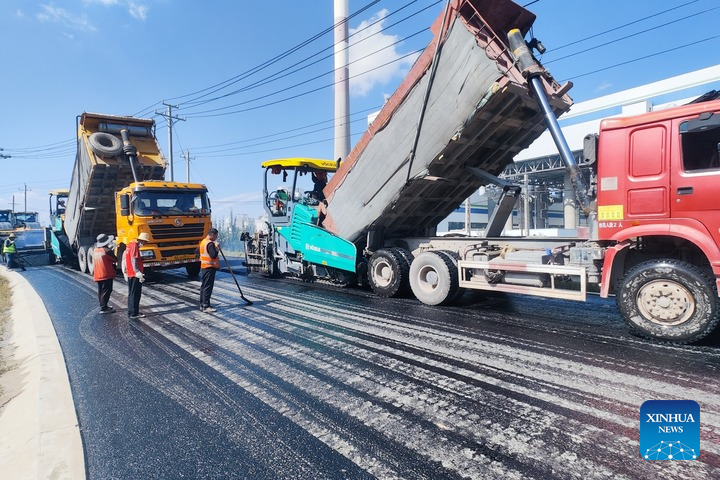New technology turns retired wind turbine blades into road pavement material
Xinhua, February 14, 2025 Adjust font size:

This photo taken on Sept. 21, 2024 shows the application of modified asphalt mixtures incorporating retired wind turbine blades on paving a road in Lanzhou, northwest China's Gansu Province. (Lanzhou Institute of Chemical Physics under the Chinese Academy of Sciences/Handout via Xinhua)
LANZHOU, Feb. 12 (Xinhua) -- A Chinese research team has developed an innovative technology that could revolutionize the way aging wind turbine blades are retired and repurposed.
After five years of research, the team led by Tang Zhicheng, from the Lanzhou Institute of Chemical Physics under the Chinese Academy of Sciences, has unveiled a solution that not only addresses the challenge of decommissioning these massive structures but also transforms them into valuable resources, promoting the sustainable development of the renewable energy sector.
China's wind power industry has experienced rapid growth in recent years, contributing significantly to global energy supply and climate change mitigation. However, wind turbines, designed with a lifespan of 20 to 25 years, are approaching retirement in large numbers.
Industry projections indicate that by 2025, China will see a wave of decommissioned wind turbines, raising questions about how to handle these aging structures.
While components such as turbine towers, hubs, and gearboxes can be recycled as scrap metal, the blades pose a unique challenge. Made from composite materials such as glass fiber, carbon fiber, and epoxy resin, wind turbine blades are lightweight, strong, and highly resistant to wind. Yet, these very properties make them difficult and costly to recycle. Currently, there is no scalable, efficient method for recycling these materials globally.
The research team has tackled the issue by leveraging the unique properties of retired blades -- lightweight, high strength, and corrosion resistance. Through a combination of physical crushing and chemical treatment, the team has successfully modified the blades for use in asphalt mixtures and cement concrete.
In collaboration with a local road construction company, the team demonstrated the application of modified asphalt mixtures incorporating retired turbine blades on a section of the Qingfu Highway in Lanzhou, northwest China's Gansu Province, in September 2024.
Wang Zhaoli, deputy general manager of the road construction company, said that the modified asphalt pavement has shown promising results after more than five months of operation. The road surface exhibited no cracks, rutting, or material detachment, indicating the feasibility of this recycling approach.
According to the research team, this technology is set to undergo more demonstration projects this year, with continued collaboration between research institutions and industry partners. These efforts aim to provide a reliable and scalable solution for recycling decommissioned wind turbine blades.
Tang said that as recycling technologies advance, the large number of decommissioned wind turbine blades could be repurposed into valuable "urban mineral resources."
This shift would not only bolster the sustainable development of the renewable energy industry but also contribute to achieving China's dual carbon goals of peaking carbon emissions by 2030 and attaining carbon neutrality by 2060, Tang added.